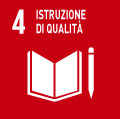- Docente: Serena Silvi
- Crediti formativi: 6
- SSD: CHIM/03
- Lingua di insegnamento: Inglese
- Modalità didattica: Convenzionale - Lezioni in presenza
- Campus: Bologna
- Corso: Laurea Magistrale in Photochemistry and Molecular Materials (cod. 9074)
-
dal 03/03/2025 al 29/05/2025
Conoscenze e abilità da conseguire
At the end of the course the student has acquired the basic concepts and the main strategies for the bottom-up construction of functional nanostructures, starting from molecules and using the paradigms of supramolecular chemistry: molecular devices and machines, dendrimers, nanoparticles, self-assembled monolayers and thin films.
Contenuti
Prerequisites: knowledge of the fundamental concepts of spectroscopy, photochemistry and electrochemistry.
Attendance: the course has no compulsory attendance.
Programme: the course deals with the following topics; for each one the general principles and some significant examples are described.
1. Introduction
What is nanotechnology?
Applications of nanotechnology
Working at the nanoscale
2. Supramolecular chemistry
Supramolecular interactions
Host-guest chemistry
Self-assembly
3. Multicomponent molecular species
Nanosystems with peculiar topologies
Dendrimers
4. Supramolecular catalysis and nanoreactors
Catalytic processes inside molecular and supramolecular hosts
Self-replication
Micelle and vesicle-based systems
5. Chemical functionalization of surfaces
The Langmuir-Blodgett technique
Functional self-assembled monolayers
Characterization and imaging of surfaces
6. Nanomaterials
Size effect and quantum confinement
Metal and semiconductor nanoparticles
Carbon-based nanomaterials
Nanoporous materials
7. Mechanical molecular machines and motors
Basic principles
Biomolecular motors
Artificial molecular machines: recent achievements and potential applications
Testi/Bibliografia
The course covers advanced topics of great scientific relevance and therefore in continuous evolution. There is no textbook covering the whole program; the following texts are recommended for the study and in-depth study of parts of the course:
1) J.-M. Lehn, Supramolecular Chemistry – Concepts and Perspectives, VCH, Weinheim, 1995 (part 1, 2, 4 of the programme).
2) V. Balzani, A. Credi, M. Venturi, Molecular Devices and Machines – Concepts and Perspectives for the Nanoworld, Wiley-VCH, Weinheim, 2008 (parti 1, 3, 7).
3) D. S. Goodsell, Bionanotechnology: Lessons from Nature, Wiley, New York, 2004 (part 1 and 7).
4) C. N. R. Rao, A. Muller, A. K. Cheetham (Eds.), The Chemistry of Nanomaterials, Vol. 1 e 2, Wiley-VCH, Weinheim, 2004 (part 1 and 6).
Other relevant recommended references will be reported on the slides of the presentations used in class.
Metodi didattici
The module is carried out in the second semester, and consists of class lectures that illustrate the basic principles of supramolecular chemistry and nanosciences; for each specific topic, the introductory concepts as well as some singificant examples taken from the scientific literature are presented.
Modalità di verifica e valutazione dell'apprendimento
Oral examination.
Strumenti a supporto della didattica
Overhead projector, PC, video projector, powerpoint presentations, videos.
Orario di ricevimento
Consulta il sito web di Serena Silvi
SDGs

L'insegnamento contribuisce al perseguimento degli Obiettivi di Sviluppo Sostenibile dell'Agenda 2030 dell'ONU.
